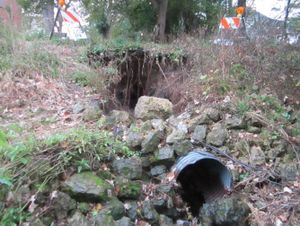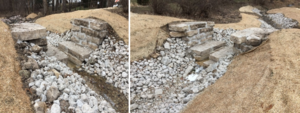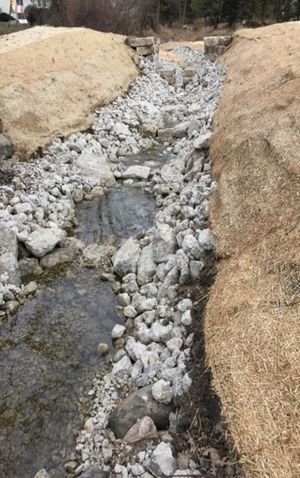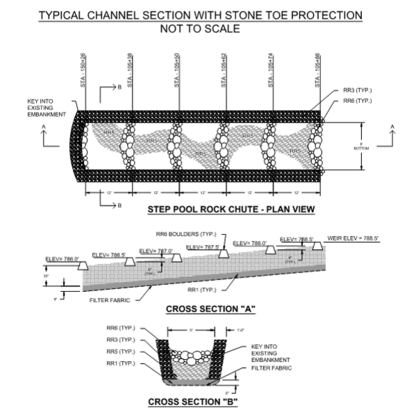
Case studies for high-gradient stormwater step-pool swale
Contents
Village of Algonquin, Kane County, Illinois - Step pool swale
- Location: Village of Algonquin, Kane County, Illinois
- Owners: Village of Algonquin
- Designer: HR Green
- Year of Completion: November 2018 – December 2018
- Design Features: 64 ln-ft step-pool swale, two-stage formal weir
- Total Drainage Area: 430 acres of mixed residential
- Total Construction Cost: $102,000
Project Summary – Souwanas Creek
HR Green worked with the Village of Algonquin, Kane County, Illinois, to address major gulley erosion and a failing culvert that threatened private properties and downstream water quality. The project area is largely developed with 430 acres of largely mixed residential and commercial development, of which 170 acres is impervious. Runoff from the watershed discharges to the Fox River approximately 3,600 feet downstream from the project site. The project addressed a failing corrugated metal culvert and downstream gulley erosion that led to a six-foot sinkhole downstream of the culvert. Given that the existing culvert had failed to prevent slope erosion at its outfall, a system was designed to safely convey runoff at the bottom of the slope.
This project consists of the following elements to safely convey water down a moderately steep, erodible slope.
- A grouted limestone weir structure to detain and regulate watershed flows above the slope
- A rocked step-pool swale to convey water to the bottom of the slope
- A stable outfall to the Souwanas Creek
- Native plant revegetation
The total length of the step-pool swale was 64 linear feet, 6 feet in cross section and placed at a 3-4 percent overall grade. At the step-pool swale’s outfall, runoff was discharged to the intermittent flow channel of Souwanas Creek. The project was built in the winter to avoid wet conditions that had potential to undermine the construction.
Though this channel is mapped as a Water of the United States (WOTUS), the flow regime is very similar to most step-pool swale conditions. This case study is not intended to reflect stream restoration or stabilization nor present any guidance for fluvial systems management.
The project was designed and constructed from November, 2018 to December, 2018.
Design Consideration Summary
Each element of the project followed local regulatory requirements during the analysis and design of the resulting system. A major design consideration was detention of flows above the step-pool system to regulate flows. A grouted limestone weir structure was designed to control the flow of water to ensure step-pool stability. This two-stage weir allows normal flow conditions to pass directly to the step-pool swale while the 2-year event flows pass through the second stage. The weir is designed to route flows up to the 10-year event. The weir system was designed using XPSWMM. The resulting upstream detention area holds 0.18-acre feet of water during the 10-year storm. Flows leaving the weir were then considered when designing the step-pool swale.
The step-pool swale was designed in profile and cross section to accommodate the 3-4 percent grade leading from the weir structure to the existing downstream streambed.The step-pool consists of 12-foot long rocked runs with pools above a rocked riffle that drops 6-inches to the next run/pool segment . Rock used for these features include stone of specific grading per Section 1005 in Illinois DOT’s “Standard Specifications for Road and Bridge Construction”, herein referred to as Section 1005. The cross sectional area of this system was designed to convey up to the 10-year flows from the weir. The depth and width of the cross sectional area of the swale was determined using XPSWMM considering shear stress. Eight inches of riprap 1, as specified in Section 1005, was used to line the bottom of the graded swale with an additional 30 inches of riprap #5 rock, specified in Section 1005, placed on top. Side slopes were protected by placement of riprap 3 rock, specified in Section 1005. The swale discharged to the stable downstream streambed.
Vegetation at the site initially consisted of invasive species prior to the completion of this project (primarily Buckthorn and Reed Canary Grass). A revegetation plan was developed for the site to be installed after construction of the weir and step-pool swale. These species were identified during a previously completed survey. During the site clearing phase of this project all buckthorn, honeysuckle, and trees under 6-inch diameter at breast height were removed.
After construction, the site was revegetated with native plant species. Areas upstream of the stone weir control structure and adjacent to the step pool swale were restored with a floodplain seed mixture while areas downstream of this practice were restored with a mesic savanna seed mixture.
The floodplain seed mixture’s most predominant species were:
- Andropogon gerardii (big bluestem)
- Panicum virgatum (switch grass)
- Asclepias incarnata (swamp milkweed)
- Zizia aurea (golden alexanders).
The Mesic Savanna seed mixture was predominantly comprised of:
- Elymus hystrix (bottlebrush grass)
- Andropogon gerardii (big bluestem)
- Bromus pubescens (woodland brome)
- Echinacea purpurea (purple coneflower)
- Cassia hebecarpa (wild senna)
- Alluim cernuum (nodding wild onion)
- Tradescantia oheinsis (common spiderwort)
- Zizia aurea (golden alexanders)
The site was prepped for seeding by scarifying the ground surface prior to broadcasting the seed and seeding was performed by hand broadcast at a rate of 7.1 pounds per acre and 16.1 pounds per acre for the floodplain seed mix and mesic savanna seed mix, respectively. Erosion control blankets (SC-150BM and S-75) were used as mulching and temporary soil stabilization over the seeded areas.
For information on plants for swales in Minnesota, link here.
Applicable Costs
This project was a design-build project completed with an expedited schedule and a budget of $102,000. Quantities needed to complete this project are summarized below.
- Riprap and Stone: $58,500
- Culvert Removal and Excavation: $13,500
- Seeding: $2,000
- Flow Bypass: $15,000
- Clearing Vegetation: $1,000
- Erosion Control: $10,000
- Water District Permit Fee (McHenry Lake County): $1,439
- State Permit Fee (EcoCAT): $512
Summary of quantities - stormwater step pool case study.
Link to this table
| Item | Unit | Quantity |
|---|---|---|
| Riprap 6 | Cubic yard | 12 |
| Riprap 5 | Cubic yard | 37 |
| Riprap 3 | Cubic yard | 41 |
| Riprap 1 | Cubic yard | 37 |
| Limestone blocks | Each | 26 |
| Grout | Longitudinal section | 1 |
| Natural stone boulders (12-18 inches) | Cubic yard | 15 |
| Culvert removal | Linear foot | 75 |
| Earth excavation | Cubic yard | 193 |
| Seeding - floodplain mix | Acre | 0.21 |
| Seeding - mesic savanna mix | Acre | 0.11 |
| Turf seeding | Acre | 0.11 |
| Bypass pumping | Longitudinal section | 1 |
| Tree removal | Each | 8 |
| Brush clearing | Square yard | 445 |
| Silt fencing | Linear foot | 325 |
| Erosion blanket - S-75 | Square yard | 1017 |
| Erosion blanket - S-150 | Square yard | 533 |
| Straw mulch | Square yard | 533 |
| Temporary ditch/creek check - coir log | Each | 2 |
| Construction entrance | Longitudinal section | 1 |
Maintenance
During construction activities, on-site inspections were completed to ensure proper installation and to determine if additional erosion or sediment control measures were needed. Once construction was completed, the contractor was responsible for a period of three years to guarantee that the vegetation has successfully established.
An Operation & Maintenance (O&M) Plan was completed to address the ongoing activities to maintain the BMPs implemented in this project. These activities are outlined to ensure the project’s long-term viability with a focus on sediment and debris removal, native vegetation management, and stability of the step pool swale.
For more information on operation and maintenance of swale step pools, link here.
Monitoring and Reporting
The Village employed an ecological firm to maintain, monitor, and report on the project site for the first three growing seasons and they are expected to extend this to growing seasons 4 through 10. Long-term managing, monitoring, and reporting is to be completed at the Village’s discretion. Monitoring and reports specifically address how well the planted communities and restoration BMPs meet and maintain the 3-year performance standards for both short-term and long-term efforts. Final Construction Documents include a Planting Plan and Details Map that are used during site visits to locate planting zones and stream stabilization structures.
Restored areas will be assessed twice annually for a period of three years and at least once annually from the fourth to tenth (and beyond) years to document vegetation establishment and general conditions of the project area and structures. Installed native vegetation is required to meet the 3-Year Performance Standards found in the Performance Standards section below. Streams and watersheds are dynamic therefore channel conditions and in-stream structures shall be inspected at least twice annually during spring and fall and following intense rain events. Stream banks, riffles, and grade controls shall be monitored for changes and to understand the equilibrium of the stream channel within its riparian corridor. Signs of changes in base flow, aggradation and degradation, and changes in stream slope or sinuosity shall also be monitored and noted for future evaluation by a qualified professional.
Signs of water quality degradation, such as excessive turbidity, sediment, nutrient loading, odor, debris, and adverse changes to aquatic and terrestrial wildlife will be monitored and noted for further investigation. Sources of water quality impairments may be from off-site and not immediately evident. Upstream off-site changes in land use or land management will also then be noted along with any impacts from intense rainfall events.
At the Village’s discretion, a photographic record may be taken at the same locations, using fixed or permanent reference points, during spring and fall and following intense rainfall events. Channel changes may be measured with a survey tape, surveyor’s rod and level, or simply by visual inspection. Standard inspection forms such as the Urban Subwatershed Restoration Unified Stream Assessment by the Center for Watershed Protection are recommended to be completed in order to document both positive and negative changes in a uniform manner. A reference reach nearby or upstream with similar dimensions and flow characteristics may be compared to ascertain the project changes, impacts, and level of success.
Monitoring
- Twice annual monitoring of all communities planted with native vegetation and stream stabilization structures shall be conducted during the 3-year maintenance and monitoring period. Annual monitoring shall be conducted in the long term (4-10+ years)
- The site visit(s) each year shall be conducted between June 1 and September 30 for vegetation establishment and monitoring of in-stream structures and stream morphology.
- Each visit shall be conducted by qualified professionals with adequate plant identification skills and/or who are also able to make recommendations regarding management of native plant communities and assess performance of stream restoration BMPs. The site inspector(s) shall collaborate over the needed maintenance requirements for a given year with the Village of Algonquin.
- The vegetation monitoring shall be conducted using the meander search method to identify 1) approximate percent vegetative coverage by native and non-native species within each native plant community, 2) to create a species list for each native plant community that can be compared to installed plant lists, and 4) to make recommendations related to site management to meet 3 Year Performance Standards.
- Representative photographs of the restored native plant communities and stream stabilization areas shall be taken to document the site conditions through time.
Reporting
- An annual letter report shall be prepared and submitted to the Village of Algonquin and Chicago District Corps of Engineers at the end of each growing season and not later than December 31 of the monitoring year.
- The report shall identify management recommendations and services that have been conducted throughout the growing season and outline future management recommendations.
- The report shall include a section that addresses the required 3 Year Performance Standards found in this maintenance and monitoring plan.
- Site photographs shall be included in the report to document the site conditions.
Performance Standards
Reports will address how well the planted communities and stream restoration BMPs meet 3-year performance standards. Standard categories include native vegetation performance and stream stabilization performance standards. The stream stabilization standard did not include additional areas but guaranteed in-stream structures are stay in place, that if rock washes away that it is replaced, repair be completed using a light tracked equipment to minimize disturbance to exposed areas and that exposed bare soil must be stabilized with materials specified in the design plan. Stream structure repairs may be done with nominal dewatering techniques such as sandbag diversions. The vegetation performance standards include criteria related to native vegetation seed and herbaceous perennial planting establishment and tree planting.
O&M Performance Standards
Native Vegetation Seeding: The Contractor shall guarantee each seeded and/or planted area will meet or exceed the following performance criteria three full growing seasons after provisional acceptance: 80% total (aerial) plant cover and at least 60% relative cover by seeded and/or planted native species in each plant community (mesic prairie, wet prairie, and existing wetlands). In addition, non-native and/or invasive native species shall collectively not comprise greater than 30% relative cover in each plant community (mesic prairie, wet prairie, and existing wetlands). Opportunistic invasive/non-native shrubs and trees shall not exceed 10% of any plant community.
Additional Guarantee from Contractor: The Contractor shall guarantee in-stream and bank structures shall remain in place throughout one full year after project completion. Doing so allows structures to become sedimented into place and native vegetation to begin establishing. Although some stream adjustment is expected, if more than 10% of in-stream structures become destabilized after one year, the Contractor shall return to the site and replace rock that has been washed away. Repairs shall be done with light tracked equipment to minimize disturbance to established areas and disturbance that exposes bare soil must be stabilized with materials per the design plans. The Village reserves the right to change these directives if they are deemed to impose too much of an impact upon the project area. Repairs may be done with nominal dewatering techniques such as sandbag diversions.
This page was last edited on 12 December 2022, at 20:15.





